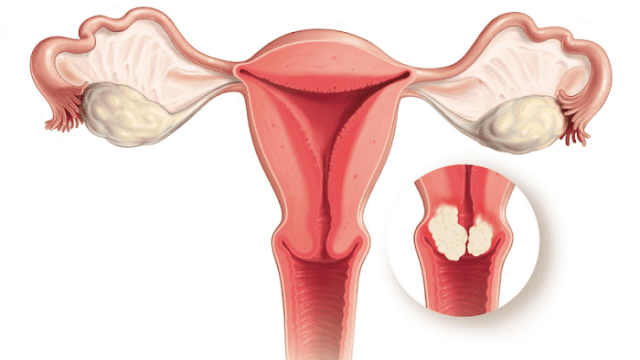What Causes Cervical Cancer
What causes cervical cancer - It has been shown that 'high risk' types of human papillomavirus (HPV) are the primary cause of cervical cancer.
Most women get at least one time in their lives one or more 'high risk' HPV types (potentially carcinogenic). The immune system can usually overcome the infection, and most women with HPV never experience problems.
In some women, however, the infection does not go away. When the virus is active in the body for a long time, cells of the cervix may start to change and the risk of cervical cancer increases.
Are there other causes of cervical cancer?
High-risk types of the HPV virus are the cause of cervical cancer. However, there are other factors that increase the likelihood that HPV infection leads to cervical cancer.
What can you do to prevent cervical cancer?
The best way to protect yourself is from your 30th year every 5 years to participate in the Population Screening for Cervical Cancer where you are screened with the smear, and in addition to the HPV test to request. On the basis of these tests, it can be determined/estimated whether abnormal cells are present or can develop, which can lead to cancer if they are not removed in time. If your smear is abnormal and the HPV test shows that you are infected with a 'high-risk' virus type, your doctor may perform an additional test: a colposcopy. This determines whether the cells must be removed.
How long does it take before cervical cancer develops?
When cells of the cervix start to change, it usually takes 10-15 years before invasive cervical cancer develops. When cells change, they first become 'pre-cancer cells' - this is also called 'dysplasia' or CIN - the abbreviation for cervical intraepithelial neoplasia.
What are the symptoms of cervical cancer?
Symptoms do not always occur in the development of cervical cancer. If that is the case, it can be:
How is the diagnosis of cervical cancer made?
Cervical cancer is diagnosed through a series of tests, usually starting with a smear test. Above 30 the HPV test can be requested, followed by a colposcopy (using an enlightened augmentation device to examine the cervix) and biopsy (a tissue sample is removed for analysis in a laboratory).
Most women get at least one time in their lives one or more 'high risk' HPV types (potentially carcinogenic). The immune system can usually overcome the infection, and most women with HPV never experience problems.
In some women, however, the infection does not go away. When the virus is active in the body for a long time, cells of the cervix may start to change and the risk of cervical cancer increases.
Are there other causes of cervical cancer?
High-risk types of the HPV virus are the cause of cervical cancer. However, there are other factors that increase the likelihood that HPV infection leads to cervical cancer.
- Exposure in the uterus to a drug called diethylstilbestrol (DES), which was prescribed to many women for miscarriage between 1938 and 1971.
- Infection with the chlamydia or herpes simplex type 2 virus (these are different types of sexually transmitted diseases).
- A relative in the first degree (mother or sister) with a history of cervical cancer. According to the International Journal of Cancer, this triples the personal risk.
- A state of health that weakens the immune system of the body, such as HIV / AIDS.
- Smoking, making the body less able to overcome infections. [One study even found that smokers are 60 percent more likely to develop cervical cancer, and ex-smokers 12 percent more likely.]
- A low level of folic acid (a type of vitamin B).
- Some data suggest that prolonged use of oral contraceptives (10 years or longer) may increase the risk of some types of cervical cancer.
What can you do to prevent cervical cancer?
The best way to protect yourself is from your 30th year every 5 years to participate in the Population Screening for Cervical Cancer where you are screened with the smear, and in addition to the HPV test to request. On the basis of these tests, it can be determined/estimated whether abnormal cells are present or can develop, which can lead to cancer if they are not removed in time. If your smear is abnormal and the HPV test shows that you are infected with a 'high-risk' virus type, your doctor may perform an additional test: a colposcopy. This determines whether the cells must be removed.
How long does it take before cervical cancer develops?
When cells of the cervix start to change, it usually takes 10-15 years before invasive cervical cancer develops. When cells change, they first become 'pre-cancer cells' - this is also called 'dysplasia' or CIN - the abbreviation for cervical intraepithelial neoplasia.
What are the symptoms of cervical cancer?
Symptoms do not always occur in the development of cervical cancer. If that is the case, it can be:
- unusual vaginal discharge or bleeding (especially after having sex).
- lower back pain.
- pain when urinating (especially in combination with pain in the lower abdomen).
- pain during sex.
How is the diagnosis of cervical cancer made?
Cervical cancer is diagnosed through a series of tests, usually starting with a smear test. Above 30 the HPV test can be requested, followed by a colposcopy (using an enlightened augmentation device to examine the cervix) and biopsy (a tissue sample is removed for analysis in a laboratory).
*Image source : Human N Health
References :

Post a Comment for "What Causes Cervical Cancer"